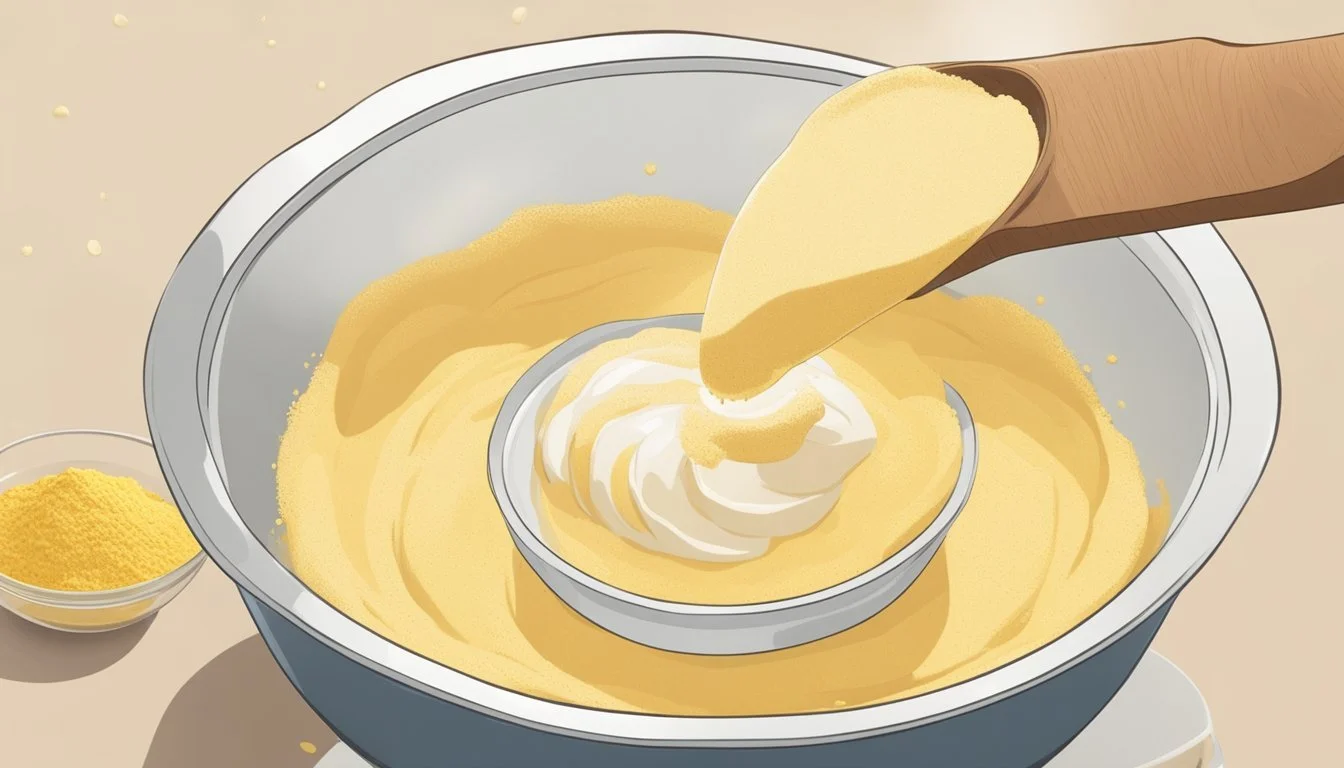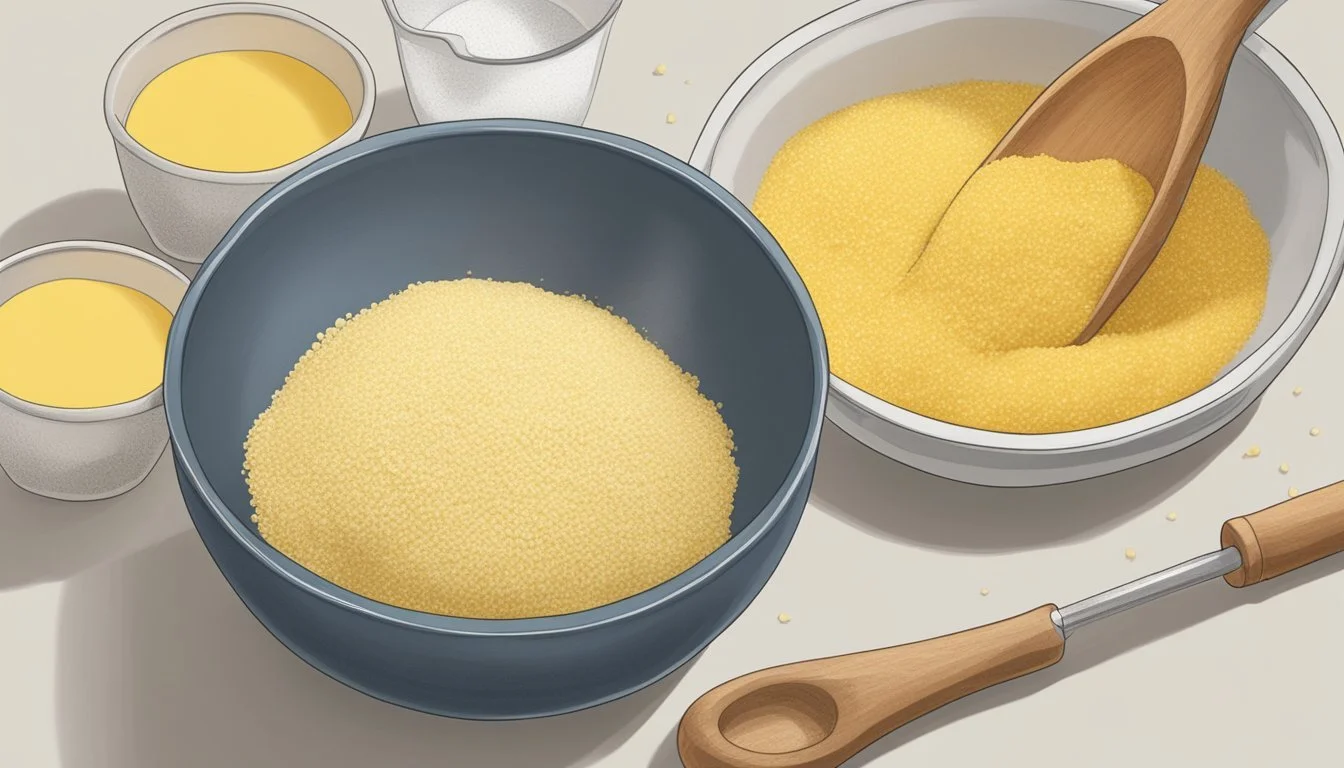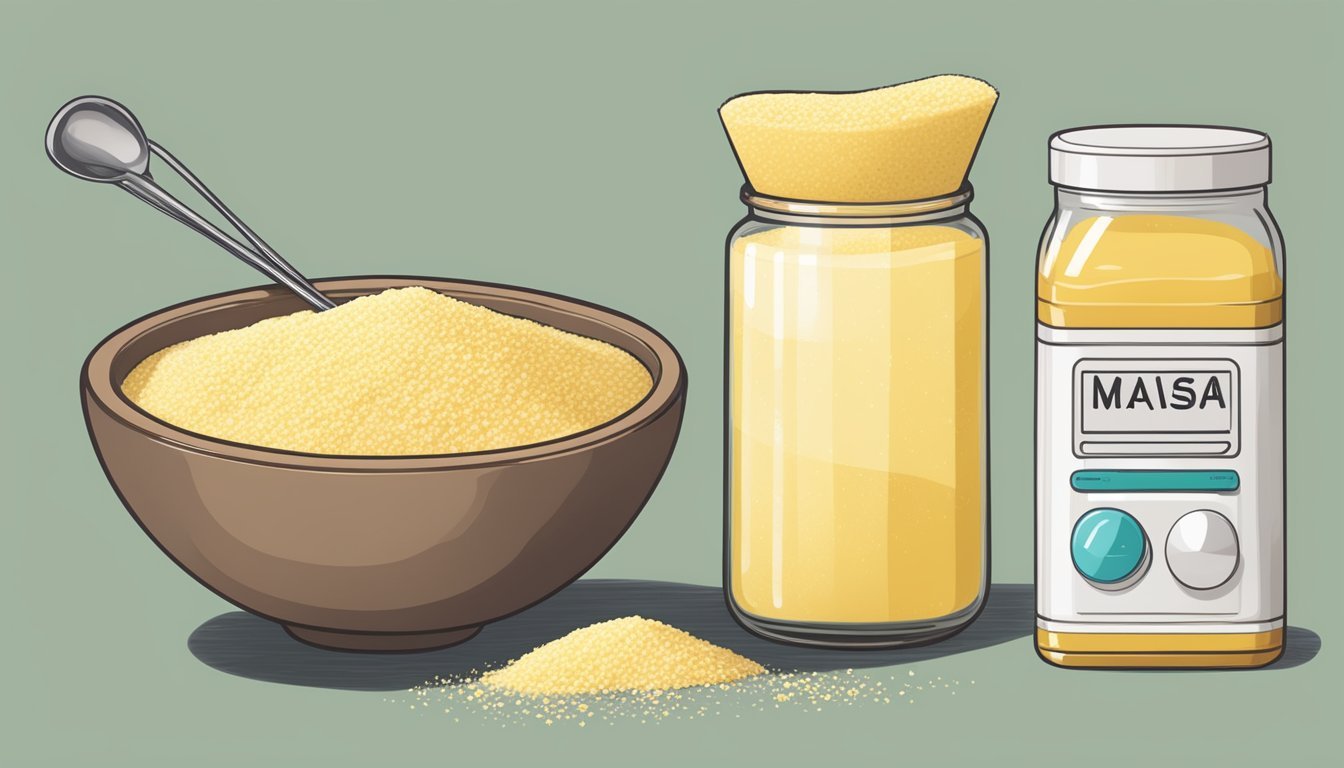How to Substitute Masa Harina for Cornmeal
A Simple Guide
Masa harina, a staple in Latin American cuisine, is finely ground corn flour made from corn kernels that have been treated with lime or wood-ash lye, a process known as nixtamalization, which imbues it with a distinctive sour flavor and increases its nutritional value. Primarily used for making tortillas, tamales, and other traditional dishes, masa harina's unique properties are difficult to replicate due to this treatment. However, when unavailable, cooks may need to find suitable substitutes that can mimic its qualities as closely as possible.
Cornmeal, often proposed as an alternative, is made from dried and ground corn but typically lacks the characteristic flavor and texture of masa harina since it is not treated with lime. While both cornmeal and masa harina originate from corn, their differences are pronounced in terms of their culinary uses and final taste in dishes. When looking for substitutes, one must consider the intended application; for instance, in applications where masa harina acts as a thickener, finely ground corn flour or even wheat flour can serve as potential alternatives, though the resulting flavor profile will change.
Understanding Masa Harina
Masa harina is a traditional flour used in Mexican cuisine that offers distinct characteristics due to its unique processing and nutritional components.
Origins and Processing
Masa harina, literally translating to "dough flour" in Spanish, originates from a process known as nixtamalization. This involves soaking and cooking corn kernels in an alkaline solution, typically limewater, which is rich in calcium hydroxide. The treatment improves the nutritional value by increasing the available calcium content, often making it a significant source in diets. It also allows the protein and niacin in the corn to become more digestible and the kernels easier to hull. Once the kernels are nixtamalized, they are ground to produce a fine, malleable flour known as masa harina.
Culinary Uses
Masa harina is fundamental in Mexican cuisine and is used to create an array of traditional dishes. Its primary use is for making corn tortillas, but it is also crucial for dishes such as tamales, pupusas, and gorditas. These foods hinge on masa harina's distinct texture and flavor, which cannot be easily replicated with other types of flour or meal.
Nutritional Profile
Masa harina is a nutritious flour alternative, providing a source of protein and minerals such as iron. Additionally, it is naturally gluten-free, making it an essential ingredient for those with gluten intolerance or celiac disease looking to enjoy traditional Mexican dishes. Here's a brief overview of its nutritional components per 100g serving:
Nutrient Amount Calories 365 kcal Protein 9.3 g Calcium 285 mg Iron 3.42 mg Dietary Fiber 7.3 g
The presence of dietary fiber contributes to digestive health, while the absence of gluten offers a suitable option for a wider range of dietary needs.
The Role of Cornmeal
Cornmeal serves as a versatile component in various cuisines, prized for its different textures and nutritional profile. It offers an array of uses from creating rustic breads to acting as a gluten-free alternative in recipes.
Types and Texture
Cornmeal comes in several varieties, which determine its texture. Fine cornmeal, often referred to as corn flour, has a powdery texture and is commonly used for a smooth consistency in baking. Medium-grit cornmeal is the standard for most recipes requiring a bit of texture, like cornbread. Coarse cornmeal is used in making polenta, which is creamier and less gritty than grits. They are the result of grinding dried corn kernels, but the granularity varies significantly across types.
Common Uses
Cornmeal is frequently utilized in baking for its unique properties, adding a crumbly and textured quality to breads and pastries. It is the foundation for cornbread, and the coarse version forms the base for traditional polenta and grits, two staple dishes in Italian and Southern American cooking, respectively.
Common Cornmeal-Based Dishes Cornbread Polenta Grits Pancakes Batters
One can also use cornmeal as a dusting for pizza stones and baking surfaces to prevent sticking and burning.
Nutrition Benefits
Cornmeal is not only a culinary staple but also a contribution to a nutritious diet. It is naturally gluten-free, making it suitable for those with gluten sensitivities. Rich in fiber, cornmeal can aid digestion and provide a sense of fullness. In addition to fiber, cornmeal contains essential minerals like iron and some protein. It falls short of being a complete protein source, but it can still contribute to one's daily protein intake.
Nutrient Benefit Fiber Aids in digestion and promotes fullness Iron Important for blood health Protein Supports muscle repair and growth
Due to its gluten-free nature, cornmeal serves as a valuable ingredient for people requiring gluten-free diet options.
Substituting Masa Harina for Cornmeal
When replacing cornmeal with masa harina, one must be mindful of the changes in texture and flavor that this substitute will bring to recipes.
Considerations for Texture
Masa harina, a traditional Latin American flour made from nixtamalized corn, has a finer, smoother consistency than the coarser grind of cornmeal. In recipes where cornmeal provides a gritty texture, such as in cornbread, substituting masa harina will result in a softer, less crumbly product. For uses that require the mixture to hold together, like in making tortillas or tamales, masa harina may actually be more effective than cornmeal.
Flavor Compatibility
Cornmeal imparts a sweet, earthy flavor, while masa harina has a distinctive tartness due to its preparation process involving soaking in a limewater solution. This difference in flavor should be considered, especially in recipes where the taste of corn is a prominent feature. Masa harina will complement dishes with a Mexican or Central American profile and can also serve as a thickener with a unique flavor profile in soups and stews.
Baking and Cooking Adjustments
When using masa harina in baking, adjustments may be required if the original recipe included leavening agents like baking soda. As masa harina does not react the same chemically, modifications to amounts or the inclusion of additional ingredients such as wheat flour might be necessary. Heed the proportion of liquids as well, since masa harina can absorb more moisture than cornmeal, potentially altering the wetness of the dough.
In summary, while masa harina can substitute for cornmeal, it is crucial to consider the impacts on texture, flavor, and recipe adjustments to ensure desired results.
Alternative Substitutes for Cornmeal
When substituting cornmeal in recipes, one has several options ranging from flour-based to gluten-free alternatives. These substitutes can provide similar textural properties although flavors may vary.
Flour-Based Alternatives
All-Purpose Flour: A common and versatile substitute, but it lacks the distinct corn flavor.
Flour Type Use Case Wheat Flour Thickening soups, sauces, and stews.
Corn Flour: Milled from the whole corn kernel, corn flour has a finer texture and can be used to mimic the consistency of cornmeal.
Gluten-Free Alternatives
For individuals with a gluten intolerance or celiac disease, the following substitutes are suitable:
Rice Flour: A fine texture similar to corn flour, ideal for thickening and used in gluten-free baking.
Gluten-Free Flour Use Case Cornstarch Thickening agent for soups, stews, and sauces. Arrowroot Powder Gives a glossy finish and thickens without graininess. Potato Starch Provides elasticity and moisture to baked goods.
Flaxseed: Ground flaxseed can serve as a binding agent in recipes and impart a nutty flavor. It's also a healthful, gluten-free option.
Homemade Cornmeal Substitutes
The ability to create a homemade substitute allows for closer approximation of cornmeal's properties.
Ground Hominy: Prepared from dried maize kernels that have been treated, ground hominy can be used in a 1:1 ratio.
Homemade Substitute Preparation Ground Hominy Grind in a food processor to desired consistency.
These alternatives should be selected based on the desired outcome of the recipe and dietary requirements.
Recipes and Applications
When substituting masa harina for cornmeal, cooks should focus on texture and flavor adjustments specific to recipes. Masa harina offers finer texture and a distinctive taste due to its preparation process, which may enrich the final dish but also require modifications.
Adjusting Traditional Recipes
For traditional Mexican and Latin American dishes such as tortillas and tamales, substituting masa harina for cornmeal is straightforward because masa harina is usually the preferred ingredient. However, when adapting recipes like soups, stews, and empanadas that typically call for cornmeal, one should consider the following:
Texture: Masa harina has a finer consistency than cornmeal and may result in a smoother texture.
Flavor: It has a lime-infused tang, which can influence the overall taste profile.
Adjust recipes by starting with equal parts substitution and tweak as needed.
Innovative Dishes with Masa Harina
Masa harina is not limited to traditional uses and can be incorporated into innovative dishes to add a gluten-free and Latin-inspired twist.
Creative applications include:
Taco shells: Use masa harina for a homemade, authentic taste.
Sauces: It acts as a thickening agent imparting a subtle flavor.
Experiment by adding masa harina to your favorite recipes and observe the unique characteristics it brings to the dish.
Gluten-Free Cooking
In gluten-free cooking, masa harina shines as an excellent substitute for wheat-based flours. Its fine texture and binding properties make it suitable for numerous gluten-free dishes:
Baked goods: Use in place of flour for a gluten-free option, keeping in mind the distinct flavor.
Breading: It can serve as a gluten-free breading for fried foods.
Remember masa harina's origin and flavor profile when incorporating it into gluten-free Mexican and Latin American recipes for an authentic touch.
Health Considerations of Masa Harina and Cornmeal
When considering masa harina and cornmeal as dietary options, one should examine their nutritional profiles, particularly in relation to fiber content, and the presence of vitamins and minerals. These factors can significantly influence weight management and overall health.
Fiber and Weight Loss
Masa harina and cornmeal both contain fiber, an essential nutrient for weight loss and digestive health. Dietary fiber aids in creating a feeling of fullness, which can reduce overall calorie intake. Specifically, fiber:
Helps maintain bowel health.
Lowers cholesterol levels.
Assists in controlling blood sugar levels.
While both provide fiber, the exact amounts can vary depending on the processing of the corn.
Vitamins and Minerals
These corn-based products are valuable sources of various vitamins and minerals. Masa harina is especially rich in this department due to the lime water processing, which increases the availability of:
Calcium: Important for bone health and muscle function.
Iron: Crucial for blood production.
Both masa harina and cornmeal contain other essential nutrients:
Protein: Necessary for the building and repair of tissues.
Potassium: Helps maintain proper heart and muscle function.
Vitamins: B vitamins support metabolism and energy production.
However, one should note that the vitamin and mineral content can differ based on whether the cornmeal and masa harina are whole grain or more refined. Whole-grain versions will typically offer more nutrients.
Tips for Working with Masa Harina
When working with masa harina, it's important to craft the dough properly, store ingredients for longevity, and adjust for varying humidity levels to ensure the best results in your recipes.
Dough Preparation
To prepare dough from masa harina for recipes such as tortillas or tamales, one must begin by combining the masa harina with a proper amount of water. The standard ratio is about 2 cups of masa harina to 1.5 cups of warm water; however, this may vary based on the brand and recipe. Knead the mixture until the dough forms a smooth ball that's pliable but not sticky, and allow it to rest for 30 minutes, covered with a damp cloth. This resting period lets the dough flour fully hydrate, which is crucial for the texture of the final product.
Storage and Preservation
Masa harina should be stored in a cool, dry place away from direct sunlight. If the package is unopened, it can generally be stored for several months. Once opened, transferring it to an airtight container can help extend its shelf life. Prepared dough made from masa harina should be used immediately or stored in the refrigerator, tightly covered, for up to 48 hours. Beyond that, one can freeze the dough, tightly wrapped in plastic, for up to three months. Defrosting should occur in the refrigerator to maintain the quality of the corn dough.
Adjustments for Humidity
Humidity can greatly affect the texture of masa harina dough. In high humidity, masa harina may require slightly less water to achieve the desired consistency, while in dry climates, a bit more water might be necessary. It's important to add water gradually and assess the dough's consistency as you mix. The perfect masa harina dough should be similar in texture to soft play dough—it should hold together without cracking or sticking to your hands. If the dough feels too dry, add water by the tablespoon. If it's too wet, add small amounts of masa harina until the desired consistency is reached.
By paying careful attention to these aspects of working with masa harina, chefs can create a variety of dishes with the authentic texture and flavor that this staple ingredient is known for.
Conclusion
When substituting masa harina for cornmeal, the key is to recognize that while both are corn-derived products, they offer different flavors and textures to recipes.
Corn Flour: This is the closest in composition and can act as a thickener, though the flavor differs due to masa harina's unique treatment.
Cornstarch: It serves well as a thickener but does not provide the distinctive taste of masa harina.
Grits or Polenta: Both can provide a similar texture in recipes, yet the flavor profile may vary.
Substitutes like rice flour or arrowroot powder may work for those with gluten intolerance, offering textural similarities without the gluten content.
It's essential to remember that each substitute will impact the overall flavor of the dish. Therefore, adjustments to spices or additional seasonings might be required to achieve the desired taste. No substitute will perfectly mimic masa harina's unique qualities, but they can provide a satisfactory alternative when necessary. Suitable applications for these substitutes include soups, stews, sauces, and baked goods.
Always consider the end goal of your recipe when selecting an alternative. Some may work better for thickening, while others might contribute to the consistency and body of the dish. Experimentation and adjustment are components of finding the perfect balance for your culinary creation without masa harina.




